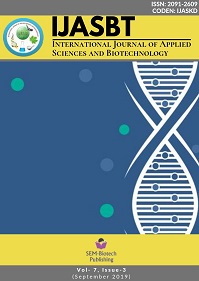Sero-Detection of Leptospira hardjo in Cattle of Bhaktapur District of Nepal
DOI:
https://doi.org/10.3126/ijasbt.v7i3.25713Keywords:
Leptospira hardjo, Bhaktapur, sero-detection, cross-sectional study, cattleAbstract
Leptospira hardjo is the most commonly reported cause of leptospirosis among cattle globally. The objective of this study was to determine sero-detection of Leptospira hardjo in cattle of Bhaktapur district of Nepal. A cross-sectional study was conducted in cattle pockets located at 4 different village development committees (VDCs) in the Bhaktapur district of Nepal. The sample collection was done in cattle to determine the sero-detection of Leptospira hardjo from February 2014 to June 2014. A total of 176 serum samples were collected from four VDCs of Bhaktapur district namely Sipadol, Dhadikot, Duwakot and Nangkhel, selected purposively. Forty samples from Sipadol, 46 Dhadikot, 42 Duwakot and 48 from Nangkhel were collected. 5 ml of blood was collected aseptically from jugular vein using 5 ml sterile disposable syringe. After that blood was transferred to the plain vacutainer. The harvested sera were transferred to serum vials and stored at in -20˚c deep freeze of Central Veterinary Laboratory until used for ELISA test. For screening of Leptospira hardjo, the Leptospira hardjo antibody test kit, ELISA (Prionics, Netherlands) was used. ANOVA along with multiple comparison test Tukey was used to compare frequency of detection across different locations in Bhaktapur district using SAS 9.4. MS-Excel was used to manage ELISA data from four different VDCs and to extract information regarding frequency of detection. There was 5.11% sero-detection in cattle of Bhaktapur district. Location wise sero-detection was 5% in Sipadol, 4.3% in Dhadikot, 4.76% in Duwakot and 6.25% in Nangkhel. The study showed that the detection of Leptospira hardjo in cattle. There was no statistical difference (P>0.05) between location suggesting that cattle in all areas are equally at risk of this pathogen. Further study is suggested on isolation and identification of disease in Nepal.
Int. J. Appl. Sci. Biotechnol. Vol 7(3): 378-381




